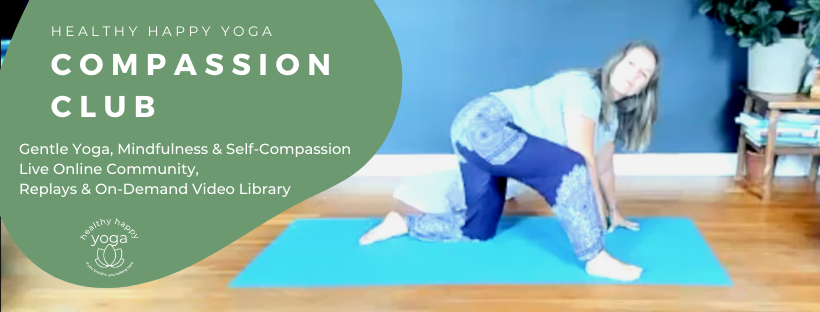
Do you feel too overwhelmed to take your life in a new, more mindful direction? Here are 5 calming practices that won't bite a chunk of time out of your day, but they WILL help you deal with your stress.
These are not really quick fixes, because you'll need to repeat them regularly to see an impact on your day to day life. The good news is, you can pick one and try it for 1-3 minutes a day. If you don't notice any change in your stress level, try something else. Find your calming anchor and let it ground you. As you get used to it, you can weave the practice into your day to day activities and it will take barely any extra time. You don't have to put on yoga pants to practice this yoga.
It is always worth it to do a calming practice. Yes, even for 30 seconds! It counts!
Here Are 5 Therapeutic Yoga Practices to Squeeze Into Your Stressful Life So You Can Relax
1. Humming Breath
Humming breath is Bhramari Pranayama in Sanskrit. When I need to regulate my nervous system quickly, I hum to myself for a few minutes.
Peter Levine has studied how to heal from trauma extensively. He teaches variations on humming to soothe and heal from trauma. Making a sound while breathing out has been shown to tone the vagus nerve. If you'd like to learn more about the vagus nerve, it is one of my favorite topics! Just comment below and ask me!
- Let your lips touch each other softly.
- Allow your tongue to drop away from the roof of your mouth and let the tip of your tongue rest against the inside of your upper teeth.
- Breathe in, and as you breathe out extend your breath in a humming sound.
- As you hum, see if you can feel the vibrations in your mouth and face. Allow the vibrations to spread out from there.
- Repeat for 5 or more breaths.
Notice how you feel after practicing Humming Breath.
2. Cherished Memory
Our brains have a lot of practice being stressed, angry, sad and worried these days. Use this meditation to help your nervous system get better at experiencing good feelings like connection, safety and love. There's a longer description of this meditation in this blog post.
Remember one moment when you felt safe and loved with someone. Pets count. Think of anyone who accepts all of you with love, and a simple cherished moment with them when you felt seen and held. Recall all the sensory details of your memory and place yourself within it.
Imagine resting back into the embrace of your memory, or floating in it. Enter the snapshot. Inhale it as if you can fill up with it. Drench your senses in your cherished memory. Feel that you’re drinking in the feelings that this memory evokes. Name the feelings. Wonder, ease, love, safety, joy…
Do this often to saturate your nervous system with the "love hormone," oxytocin, and to strengthen the neural pathways your brain creates as you experience positive feelings. Take a few minutes a day to grow your capacity for connection and joy.
Notice how you feel after practicing Cherished Memory Meditation.
3. Mindfulness With Open Eyes
The thing about meditation is, it is a practice. I've been a meditator for 25 years. I have had enough practice that I can drop into a meditative state pretty easily. I know what a calm heart and mind feel like, and I have tools to reconnect with that feeling. I could close my eyes and breathe or chant and feel better momentarily. The calm would stay with me for a while and usually help me fall asleep. But I wasn’t using those tools in my day to day life. It felt like all or nothing. I was either freaking out, advocating for my son with perpetual urgency, or I was meditating.
Mindfulness is different. The intention is not to close off to the world for a specified amount of time and then rejoin life, but to integrate awareness into everyday activities, to notice thoughts as they are happening, to know that we have choices each and every moment in how we feel, think and behave. That doesn’t mean we don’t also dedicate time to practice. The simplest way to describe it is the difference between eyes closed and eyes open.
Sit and tell your busy mind that you are going to practice mindfulness. Keep your eyes softly open, gazing slightly down, but not staring at anything. As soon as you tell your mind you are going to be mindful, it will dump your entire to-do list on you like a trash can over your head. Instead, try to NOT be mindful. Focus on not being mindful and see if you can do it.
When thoughts arrive, thank them for coming and go back to what you were doing. You can try saying "thinking" to yourself when you notice a nagging thought.
Start with just a few moments, and build up. Don't make it a big to-do, and don't seek out quiet, calm spaces to practice. The idea is that we don't need specific circumstances to practice mindfulness, we can integrate it into our hectic lives. I love to practice on the subway or at the dentist.
Notice how you feel after practicing Mindfulness With Open Eyes.
4. Zap Loving Kindness
Here's another one I do on the subway, but you can try it walking down the street, at the mall, anywhere that is relatively crowded with people. The first step is to get off your phone and notice everyone around you. Smile to yourself in a subtle way that isn't forced, as if you are recalling a cherished memory.
Without staring at anyone, see them one at a time with friendliness. Start to silently send a positive affirmation out to every person you see, rapid-fire. I think to myself, "May you be well," on repeat, but you can make up your own short wish. This is a form of loving kindness practice. Your goal is to go completely unnoticed. Be stealthy as you "zap" each person you pass with your affirmation. This is not about having an exchange, it is only about secretly sending out good will to as many strangers as you can, randomly and indiscriminately. Be like the sun, who shines on everyone!
Notice how you feel after practicing Zap Loving Kindness. We might imagine we would feel depleted by sending out so much generosity to others, but I always feel replenished and more connected to the world afterwards.
5. Hit the Pause Button
Stop. When you stop, the world will actually continue spinning without you.
- Wherever you are, whatever you are doing, simply pause. Take a breath and follow the full breath. Rest back into non-doing.
- When your mind wants to take action, invite it back into your body for one more breath. Remember the benefits of inaction.
- Do this one more time for a total of 3 breaths. Open your senses. Notice your environment, your body, your thoughts.
Start with 3 breaths whenever you remember. If you are having a hard time remembering, set an alarm. Commit to being present for all three breaths. Then continue with whatever you were doing. Take mindfulness with you into action.
The cool thing is, sometimes things resolve without us doing anything. This can be hard to accept if you are hyper-vigilant like me, but it is true. The world keeps on spinning.
Notice how you feel after Hitting the Pause Button.
A Calming Practice Becomes Like An Old Cozy Sweater
You will find your anchor of calm. Once you do, stick with it. You will get bored, and eventually the shine will wear off your calming practice. Stay with it, just like you keep reaching for your old cozy sweater, and for all the same reasons.
Please let me know in the comments if you try one of these practices. If you'd like, after getting calm, you can do some self-inquiry around your deeply held beliefs regarding stress and the lack of time to care for yourself.
Try On A Mindset Of Spaciousness
When I was young and my mom taught me about art, she emphasized the negative space. Look at a tree. See the branches. Now, soften your gaze so you can see the spaces of sky between the leaves and branches. Even a voluminous tree in full bloom has space between the branches.
We have more space in our day than we acknowledge. If we pause, something interesting happens. Things continue to get done without us directing everything. That can be a relief... but there might be something else underneath that relief.
- What does it mean if we are not needed by others every single moment of every day?
- What if there actually is a little spaciousness in between the many demands of life?
- What if you see that there's a little space, but you are used to getting validation from your caregiving and/or productivity?
- What if you are so used to running from crisis to crisis that you can no longer see the spaces in between?
- Where does it leave you if your self-worth has become entwined with caretaking and/or how much you produce?
I get it! Life has been a blur. It isn't easy, and there's no doubt your life is exceptionally demanding.
Where does it leave us when we have been using busyness to avoid our sadness or fear? It leaves us with a little work to do on ourselves. You are not isolated in this, even though this is inner work. Others, including me, are also wondering about care and time, busyness and spaciousness, and the unsustainable demands of this culture.
First, self-regulate with one of these calming practices. Then, ask yourself one of the self-inquiry questions above, and invite yourself to consider a more spacious mindset. You can journal or simply rest back into the inquiry, knowing you are cherished. May you be well!

If you'd like ongoing support, accountability and community to continue to practice these therapeutic calming tools and many more, get on the waitlist for the Compassion Club. Enrollment will open this fall!
Stop Walking On Eggshells!
Gentle yoga to release your stress and shift your mindset about struggle.
If you get your buttons pushed often by other people's issues, you may be hypervigilant. You might feel it in your body as clenching, tension, or chronic pain.
You'll become more grounded in awareness of your body.


